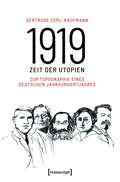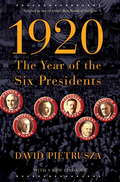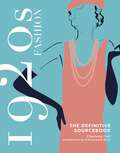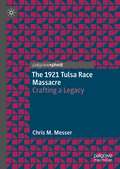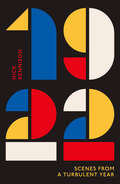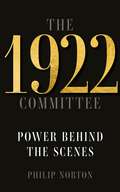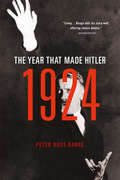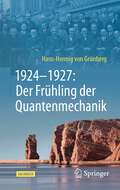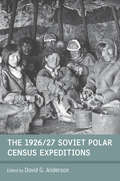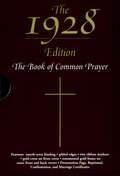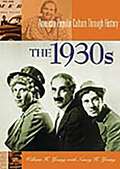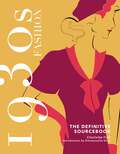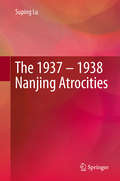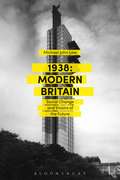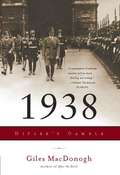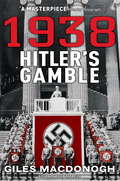- Table View
- List View
1919 - Zeit der Utopien: Zur Topographie eines deutschen Jahrhundertjahres (Histoire #151)
by Gertrude Cepl-Kaufmann1919 - ein Ausnahmejahr zwischen Kaiserreich und Republik: Das föderale Deutschland meldete sich zurück. Gertrude Cepl-Kaufmann präsentiert das turbulente Jahr als Panorama inszenierter Stadtporträts und bietet ein Wimmelbild zu der Frage, wie das Deutschland der Zukunft damals aussehen sollte: wie das revolutionäre Kiel, die Räterepublik in München, das besetzte Rheinland? Mit der Dynamik weg vom Preußischen Militarismus und hin zum Pazifismus hing Wandel in der Luft - mit Utopien für morgen, »Menschheitskathedralen«, neuen Schulen wie dem »Bauhaus«. Nie gab es so viel Zukunft, Freiheit, Zensurlosigkeit, bis die ›warlords‹ mit ihrer Dolchstoßlegende die Bühne betraten. »Die Welt neu denken« lautet das Motto im Gedenkjahr zur Bauhausgründung in NRW. »1919 - Zeit der Utopien« ist Teil des Projektes »100 jahre bauhaus im westen«.
1920: The Year of the Six Presidents
by David PietruszaThe presidential election of 1920 was among history's most dramatic. Six once-and-future presidents-Wilson, Harding, Coolidge, Hoover, and Teddy and Franklin Roosevelt-jockeyed for the White House. With voters choosing between Wilson's League of Nations and Harding's front-porch isolationism, the 1920 election shaped modern America. Women won the vote. Republicans outspent Democrats by 4 to 1, as voters witnessed the first extensive newsreel coverage, modern campaign advertising, and results broadcast on radio. America had become an urban nation: Automobiles, mass production, chain stores, and easy credit transformed the economy. 1920 paints a vivid portrait of America, beset by the Red Scare, jailed dissidents, Prohibition, smoke-filled rooms, bomb-throwing terrorists, and the Klan, gingerly crossing modernity's threshold.
1920: The Year of the Six Presidents
by David PietruszaThe presidential election of 1920 was one of the most dramatic ever. For the only time in the nation's history, six once-and-future presidents hoped to end up in the White House: Woodrow Wilson, Warren G. Harding, Calvin Coolidge, Franklin Delano Roosevelt, Herbert Hoover, and Theodore Roosevelt. It was an election that saw unprecedented levels of publicity -- the Republicans outspent the Democrats by 4 to 1 -- and it was the first to garner extensive newspaper and newsreel coverage. It was also the first election in which women could vote. Meanwhile, the 1920 census showed that America had become an urban nation -- automobiles, mass production, chain stores, and easy credit were transforming the economy and America was limbering up for the most spectacular decade of its history, the roaring '20s. Award-winning historian David Pietrusza's riveting new work presents a dazzling panorama of presidential personalities, ambitions, plots, and counterplots -- a picture of modern America at the crossroads.
1920s Fashion: The Definitive Sourcebook
by Charlotte Fiell'There isn't a more comprehensive source to Twenties fashion that I can think of ... An absolute must for anyone interested in Twenties fashion or art deco' Style High Club'A source of all the styles, colours, shapes, and silhouettes of the Golden Twenties' VogueFrom the glitz and glamour of the Roaring Twenties came a fashion revolution. The 1920s is a decade synonymous with social change, reflected in its groundbreaking fashions: from the daring elegance of the 'New Woman' to never-before-seen silhouettes, the styles of the Roaring Twenties still capture the imagination a century later.Sumptuously illustrated with over 500 original photographs, sketches and prints, this extensive sourcebook documents the season-by-season fashions of the Jazz Age. Follow the evolving fashion trends and uncover a fascinating analysis of the progression from haute couture to ready-to-wear in this essential handbook for all fashion historians, students and vintage enthusiasts.Authored and edited by renowned design historian, Charlotte Fiell, this volume also contains an authoritative introduction by fashion historian Emmanuelle Dirix, as well as the biographies of the key designers and fashion houses of the period.
The 1921 Tulsa Race Massacre: Crafting a Legacy
by Chris M. MesserThis book examines the Tulsa Race Massacre of 1921, perhaps the most lethal and financially devastating instance of collective violence in early twentieth-century America. The Greenwood district, a comparably prosperous black community spanning thirty-five city blocks, was set afire and destroyed by white rioters. This work analyzes the massacre from a sociological perspective, extending an integrative approach to studying its causes, the organizational responses that followed, and the complicated legacy that remains.
1922: Scenes from a Turbulent Year
by Nick Rennison1922 was a year of great turbulence and upheaval. Its events reverberated throughout the rest of the twentieth century and still affect us today, 100 years later.Empires fell. The Ottoman Empire collapsed after more than six centuries. The British Empire had reached its greatest extent but its heyday was over. The Irish Free State was declared and demands for independence in India grew. New nations and new politics came into existence. The Soviet Union was officially created and Mussolini's Italy became the first Fascist state.In the USA, Prohibition was at its height. The Hollywood film industry, although rocked by a series of scandals, continued to grow. A new mass medium - radio - was making its presence felt and, in Britain, the BBC was founded. In literature it was the year of peak modernism. Both T. S. Eliot's The Waste Land and James Joyce's Ulysses were first published in full.In society, already changed by the trauma of war and pandemic, the morals of the past seemed increasingly outmoded; new ways of behaving were making their appearance. The Roaring Twenties had begun to roar and the Jazz Age had arrived.1922 also saw the discovery of Tutankhamun's tomb, the arrest of Mahatma Gandhi, the death of Marcel Proust, the election of a new pope, the first use of insulin to treat diabetes, the release of Nosferatu, the first major vampire movie, and the brief imprisonment in Munich of an obscure right-wing demagogue named Adolf Hitler.In a sequence of vividly written sketches, Nick Rennison conjures up all the drama and diversity of an extraordinary year.'A tremendous, beguiling read' - William Boyd
The 1922 Committee: Power behind the scenes
by Philip NortonThe Conservative Private Members (1922) Committee is an important but elusive force in British politics. Despite becoming almost a household name during the leadership crises of 2022, it remains little understood beyond the corridors of Westminster.Established in 1923 by a group of Conservative MPs elected the year before, the Committee offers backbenchers an opportunity to discuss their views and coordinate independently of the frontbench. Over time it has become the kingmaker of the Conservative Party, overseeing leadership elections and confidence votes such as that faced by Boris Johnson over ‘partygate’.How did the Committee come together? How is it structured and how much power does it really wield? These are among the questions the book considers. Providing unprecedented insights into this long-standing institution, it is essential reading for anyone who cares about the integrity of our political system.
The 1922 Committee: Power behind the scenes
by Philip NortonThe Conservative Private Members (1922) Committee is an important but elusive force in British politics. Despite becoming almost a household name during the leadership crises of 2022, it remains little understood beyond the corridors of Westminster.Established in 1923 by a group of Conservative MPs elected the year before, the Committee offers backbenchers an opportunity to discuss their views and coordinate independently of the frontbench. Over time it has become the kingmaker of the Conservative Party, overseeing leadership elections and confidence votes such as that faced by Boris Johnson over ‘partygate’.How did the Committee come together? How is it structured and how much power does it really wield? These are among the questions the book considers. Providing unprecedented insights into this long-standing institution, it is essential reading for anyone who cares about the integrity of our political system.
1923: The Mystery of Lot 212 and a Tour de France Obsession
by Ned BoultingThe story of an obsession. When cycling commentator Ned Boulting bought a length of Pathé news film featuring a stage of the Tour de France from 1923 he set about learning everything he could about it - taking him on an intriguing journey that encompasses travelogue, history and detective story.In the autumn of 2020 Ned Boulting (ITV head cycling commentator and Tour de France obsessive) bought a length of Pathé news film from a London auction house. All he knew was it was film from the Tour de France, a long time ago. Once restored it became clear it was a short sequence of shots from stage 4 of the 1923 Tour de France. No longer than 2.5 minutes long, it featured half a dozen sequences, including a lone rider crossing a bridge. Ned set about learning everything he could about the sequence – studying each frame, face and building – until he had squeezed the meaning from it. It sets him off in fascinating directions, encompassing travelogue, history, mystery story – to explain, to go deeper into this moment in time, captured on his little film.Join him as he explores the history of cycling and France just five years after WWI – meeting characters like Henri Pélissier, who won the Tour that year but who would within the decade be shot dead by his lover using the same pistol with which his wife had killed herself. And Theophile Beeckman – the lone rider on the bridge.
1923: The Mystery of Lot 212 and a Tour de France Obsession
by Ned BoultingThe story of an obsession. When cycling commentator Ned Boulting bought a length of Pathé news film featuring a stage of the Tour de France from 1923 he set about learning everything he could about it - taking him on an intriguing journey that encompasses travelogue, history and detective story.In the autumn of 2020 Ned Boulting (ITV head cycling commentator and Tour de France obsessive) bought a length of Pathé news film from a London auction house. All he knew was it was film from the Tour de France, a long time ago. Once restored it became clear it was a short sequence of shots from stage 4 of the 1923 Tour de France. No longer than 2.5 minutes long, it featured half a dozen sequences, including a lone rider crossing a bridge. Ned set about learning everything he could about the sequence – studying each frame, face and building – until he had squeezed the meaning from it. It sets him off in fascinating directions, encompassing travelogue, history, mystery story – to explain, to go deeper into this moment in time, captured on his little film.Join him as he explores the history of cycling and France just five years after WWI – meeting characters like Henri Pélissier, who won the Tour that year but who would within the decade be shot dead by his lover using the same pistol with which his wife had killed herself. And Theophile Beeckman – the lone rider on the bridge.
1923: The Forgotten Crisis in the Year of Hitler’s Coup
by Mark Jones'Gripping . . . thoroughly researched and beautifully written . . . a warning for our times' Alex Watson, author of Ring of steel'Fascinating . . . shows powerfully that there was nothing inevitable about the survival of Germany's young democracy in that year - nor about its death a decade later. A timely reminder' Katja Hoyer, author of Blood and IronThe astonishing year when German democracy faced crisis and near destruction.1923 was one of the most remarkable years of modern European history. In January, France and Belgium militarily occupied Germany's economic heartland, the Ruhr; triggering a series of crises that almost spiralled out of control. Hyperinflation plunged millions into poverty. The search for scapegoats empowered political extremes. Hitler's populism ascended to national prominence. Communists, Nazis, separatists all thought that they could use the crises to destroy democracy. None succeeded. 1923 was the year of Hitler's first victory - and his first defeat. Fanning the flames of instability, anti-government and antisemitic sentiment, the Nazis' abortive yet pivotal putsch in a Munich beer hall failed when they were abandoned by their likeminded conservative allies. Drawing on previously unseen sources, Mark Jones weaves together a thrilling and resonant narrative of German lives in this turbulent time. Tracing Hitler's rise, we see how political pragmatism and international cooperation eventually steered the nation away from total insurrection. A decade later, when Weimar democracy eventually succumbed to tyranny, the warnings from 1923 - rising of nationalist rhetoric, fragile European consensus, and underestimation the of the enemies of liberalism - became only too apparent.This account of the republic's convulsions and survival offers a gripping image of a modern society in extreme crisis.
1924: The Year That Made Hitler
by Peter Ross RangeThe dark story of Adolf Hitler's life in 1924 -- the year that made a monster. Before Adolf Hitler's rise to power in Germany, there was 1924. This was the year of Hitler's final transformation into the self-proclaimed savior and infallible leader who would interpret and distort Germany's historical traditions to support his vision for the Third Reich. Everything that would come -- the rallies and riots, the single-minded deployment of a catastrophically evil idea -- all of it crystallized in one defining year. 1924 was the year that Hitler spent locked away from society, in prison and surrounded by co-conspirators of the failed Beer Hall Putsch. It was a year of deep reading and intensive writing, a year of courtroom speeches and a treason trial, a year of slowly walking gravel paths and spouting ideology while working feverishly on the book that became his manifesto: Mein Kampf. Until now, no one has fully examined this single and pivotal period of Hitler's life. In 1924, Peter Ross Range richly depicts the stories and scenes of a year vital to understanding the man and the brutality he wrought in a war that changed the world forever.
The 1926/27 Soviet Polar Census Expeditions
by David G. AndersonIn 1926/27 the Soviet Central Statistical Administration initiated several yearlong expeditions to gather primary data on the whereabouts, economy and living conditions of all rural peoples living in the Arctic and sub-Arctic at the end of the Russian civil war. Due partly to the enthusiasm of local geographers and ethnographers, the Polar Census grew into a massive ethnological exercise, gathering not only basic demographic and economic data on every household but also a rich archive of photographs, maps, kinship charts, narrative transcripts and museum artifacts. To this day, it remains one of the most comprehensive surveys of a rural population anywhere. The contributors to this volume – all noted scholars in their region – have conducted long-term fieldwork with the descendants of the people surveyed in 1926/27. This volume is the culmination of eight years’ work with the primary record cards and was supported by a number of national scholarly funding agencies in the UK, Canada and Norway. It is a unique historical, ethnographical analysis and of immense value to scholars familiar with these communities’ contemporary cultural dynamics and legacy.
The 1928 Book of Common Prayer: Spiritual Formation Through The Book Of Common Prayer
by DavidThe 1928 Book of Common Prayer is a treasured resource for traditional Anglicans and others who appreciate the majesty of King James-style language. This classic edition features a Presentation section containing certificates for the rites of Baptism, Confirmation, and Marriage. The elegant burgundy hardcover binding is embossed with a simple gold cross, making it an ideal choice for both personal study and gift-giving. The 1928 Book of Common Prayer combines Oxford's reputation for quality construction and scholarship with a modest price - a beautiful prayer book and an excellent value.
The 1930s (American Popular Culture Through History)
by William H. YoungMost historical studies bury us in wars and politics, paying scant attention to the everyday effects of pop culture. Welcome to America's other history—the arts, activities, common items, and popular opinions that profoundly impacted our national way of life. The twelve narrative chapters in this volume provide a textured look at everyday life, youth, and the many different sides of American culture during the 1930s. Additional resources include a cost comparison of common goods and services, a timeline of important events, notes arranged by chapter, an extensive bibliography for further reading, and a subject index.The dark cloud of the Depression shadowed most Americans' lives during the 1930s. Books, movies, songs, and stories of the 1930s gave Americans something to hope for by depicting a world of luxury and money. Major figures of the age included Fred Astaire and Ginger Rogers, Irving Berlin, Amelia Earhart, Duke Ellington, the Marx Brothers, Margaret Mitchell, Cole Porter, Joe Louis, Babe Ruth, Shirley Temple, and Frank Lloyd Wright. Innovations in technology and travel hinted at a Utopian society just off the horizon, group sports and activities gave the unemployed masses ways to spend their days, and a powerful new demographic—the American teenager—suddenly found itself courted by advertisers and entertainers.
A 1930s Childhood: From Conker Fights to Coal Fires
by Colin G. MaggsDo you remember collecting birds’ eggs and cigarette cards? Or the first appearances of wrapped sweets like Mars and Milky Way? The 1930s was a time of great progress, as engines took over from horses, and electric light from gas and oil. In the background, change was everywhere, with the Mallard speed record, the abdication of the King, and the increasing spectre of the impending Second World War. It was a time of home cooking, and day-trip holidays, when families kept chickens and children played with bows and arrows. This delightfully nostalgic book will take you right back to a different age, recalling what life was like for those growing up in the 1930s.
1930s Fashion: The Definitive Sourcebook
by Charlotte FiellFrom the turbulence of the 1930s emerged the Golden Age of Glamour. Framed by two world-changing events – the economic crash of 1929 and the outbreak of the Second World War – the 1930s saw new looks emerge and thrive, despite economic and social uncertainty.This was the decade of the bias cut, the statement shoulder, the puff sleeve, the tea dress, the fur shrug and the floor-length evening gown. It was also the era that saw Hollywood challenge Paris's fashion crown and its stars become fashion icons, signalling a new grown-up direction in womenswear design.Packed with over 500 original photographs, illustrations and sketches from the decade, this is an essential guide for any fashion historian, student or vintage enthusiast. These classic images have been selected from popular fashion publications of the day, mail-order catalogues and Hollywood studio press shots, including material from Chic Parisien, Harper's Bazaar, Sears, La Femme Chic and film studios Metro-Goldwyn-Mayer and Paramount.Authored and edited by renowned design historian, Charlotte Fiell, this volume also contains an authoritative introduction by fashion historian, Emmanuelle Dirix, as well as the biographies of the key designers and fashion houses of the period.
1931: Debt, Crisis, and the Rise of Hitler
by Tobias StraumannGermany's financial collapse in the summer of 1931 was one of the biggest economic catastrophes of modern history. It led to a global panic, brought down the international monetary system, and turned a worldwide recession into a prolonged depression. The crisis also contributed decisively to the rise of Hitler. Within little more than a year of its onset, the Nazis were Germany's largest political party at both the regional and national level, paving the way for Hitler's eventual seizure of power in January 1933. The origins of the collapse lay in Germany's large pile of foreign debt denominated in gold-backed currencies, which condemned the German government to cut spending, raise taxes, and lower wages in the middle of a worldwide recession. As political resistance to this policy of austerity grew, the German government began to question its debt obligations, prompting foreign investors to panic and sell their German assets. The resulting currency crisis led to the failure of the already weakened banking system and a partial sovereign default. Hitler managed to profit from the crisis because he had been the most vocal critic of the reparation regime responsible for the lion's share of German debts. As the financial system collapsed, his relentless attacks against foreign creditors and the alleged complicity of the German government resonated more than ever with the electorate. The ruling parties that were responsible for the situation lost their credibility and became defenceless in the face of his onslaught against an establishment allegedly selling the country out to her foreign creditors. Meanwhile, these creditors hesitated too long to take the wind out of Hitler's sails by offering debt relief. In this way, a financial crisis soon developed into a political catastrophe for both Europe and the world.
1931: Debt, Crisis, and the Rise of Hitler
by Tobias StraumannGermany's financial collapse in the summer of 1931 was one of the biggest economic catastrophes of modern history. It led to a global panic, brought down the international monetary system, and turned a worldwide recession into a prolonged depression. The crisis also contributed decisively to the rise of Hitler. Within little more than a year of its onset, the Nazis were Germany's largest political party at both the regional and national level, paving the way for Hitler's eventual seizure of power in January 1933. The origins of the collapse lay in Germany's large pile of foreign debt denominated in gold-backed currencies, which condemned the German government to cut spending, raise taxes, and lower wages in the middle of a worldwide recession. As political resistance to this policy of austerity grew, the German government began to question its debt obligations, prompting foreign investors to panic and sell their German assets. The resulting currency crisis led to the failure of the already weakened banking system and a partial sovereign default. Hitler managed to profit from the crisis because he had been the most vocal critic of the reparation regime responsible for the lion's share of German debts. As the financial system collapsed, his relentless attacks against foreign creditors and the alleged complicity of the German government resonated more than ever with the electorate. The ruling parties that were responsible for the situation lost their credibility and became defenceless in the face of his onslaught against an establishment allegedly selling the country out to her foreign creditors. Meanwhile, these creditors hesitated too long to take the wind out of Hitler's sails by offering debt relief. In this way, a financial crisis soon developed into a political catastrophe for both Europe and the world.
The 1937 – 1938 Nanjing Atrocities
by Suping LuThis book presents a comprehensive overview of the Nanjing Massacre, together with an in-depth analysis of various aspects of the event and related issues. Drawing on original source materials collected from various national archives, national libraries, church historical society archives, and university libraries in China, Japan, Germany, United Kingdom and the United States, it represents the first English-language academic attempt to analyze the Nanjing Massacre in such detail and scope.The book examines massacres and other killings, in addition to other war crimes, such as rape, looting, and burning. These atrocities are then explored further via a historical analysis of Chinese survivors’ testimony, Japanese soldiers’ diaries, Westerners’ eyewitness accounts, the news coverage from American and British correspondents, and American, British and German diplomatic dispatches. Further, the book explores issues such as the role and function of the International Committee for Nanking Safety Zone, burial records of massacre victims, post-war military tribunals, controversies over the Nanjing Massacre, and the 100-Man Killing Contest.This book is intended for all researchers, scholars, graduate and undergraduate students, and members of the general public who are interested in Second World War issues, Sino-Japanese conflicts, Sino-Japan relations, war crimes, atrocity and holocaust studies, military tribunals for war crimes, Japanese atrocities in China, and the Nanjing Massacre.
1938: Social Change and Visions of the Future
by Michael John LawIn 1938: Modern Britain, Michael John Law demonstrates that our understanding of life in Britain just before the Second World War has been overshadowed by its dramatic political events. 1938 was the last year of normality, and Law shows through a series of case studies that in many ways life in that year was far more modern than might have been thought. By considering topics as diverse as the opening of a new type of pub, the launch of several new magazines, the emergence of push-button radios and large screen televisions sets, and the building of a huge office block, he reveals a Britain, both modern and intrigued by its own modernity, that was stopped in its tracks by war and the austerity that followed. For some, life in Britain was as consumerist, secular, Americanized and modern as it would become for many in the late 1950s and early 1960s. Presenting a fresh perspective on an important year in British social history, illuminated by six engaging case studies, this is a key study for students and scholars of 20th-century Britain.
1938: Social Change and Visions of the Future
by Michael John LawIn 1938: Modern Britain, Michael John Law demonstrates that our understanding of life in Britain just before the Second World War has been overshadowed by its dramatic political events. 1938 was the last year of normality, and Law shows through a series of case studies that in many ways life in that year was far more modern than might have been thought. By considering topics as diverse as the opening of a new type of pub, the launch of several new magazines, the emergence of push-button radios and large screen televisions sets, and the building of a huge office block, he reveals a Britain, both modern and intrigued by its own modernity, that was stopped in its tracks by war and the austerity that followed. For some, life in Britain was as consumerist, secular, Americanized and modern as it would become for many in the late 1950s and early 1960s. Presenting a fresh perspective on an important year in British social history, illuminated by six engaging case studies, this is a key study for students and scholars of 20th-century Britain.
1938: Hitler's Gamble
by Giles MacDonoghIn this masterful narrative, acclaimed historian Giles MacDonogh chronicles Adolf Hitler's consolidation of power over the course of one year. Until 1938, Hitler could be dismissed as a ruthless but efficient dictator, a problem to Germany alone; after 1938 he was clearly a threat to the entire world.It was in 1938 that Third Reich came of age. The Führer brought Germany into line with Nazi ideology and revealed his plans to take back those parts of Europe lost to "Greater Germany” after the First World War. From the purging of the army in January through the Anschluss in March, from the Munich Conference in September to the ravages of Kristallnacht in November, MacDonogh offers a gripping account of the year Adolf Hitler came into his own and set the world inexorably on track to a cataclysmic war.
1938: Hitler's Gamble
by Giles MacDonoghIn this masterly new work, acclaimed historian Giles MacDonogh explores the moment when Hitler gambled everything. Until 1938, Hitler could be dismissed as a ruthless but efficient dictator, a problem to Germany alone; after 1938 he was clearly a threat to the entire world.In that year The Third Reich came of age and the Führer showed his hand - bringing Germany into line with Nazi ideology and revealing long-held plans to take back those parts of Europe lost to 'Greater Germany' after the First World War. The sequence of events began in January with the purging of the army, and escalated with the merger with Austria - the Anschluss, and the first persecutions of Viennese Jewry.In the following months Hitler moulded the nation to his will. Elections brought him a 99 per cent approval rating. MacDonogh gives a full account of the nationalist opposition that failed to topple Hitler in September 1938. By the end of the year the brutal reality of the Nazi regime was revealed by Joseph Goebbels in Kristallnacht, a nationwide assault on Germany's native Jewish population.MacDonogh's access to many new sources gives insights into what life was like under the eye of the regime, revealing the role of the Anglican Church after the Anschluss, saving those Jews who were willing to convert, and also the Kendrick Affair - the still-secret details of the Austrian double agent who brought down the whole MI6 operation in Austria and Germany, just as the Chamberlain government began negotiations with Hitler at Munich. A remarkable and revealing account of Hitler's opening moves to war.
